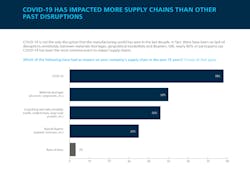There’s a healthy debate underway in the electronics industry about rethinking global supply chains. The obsession with efficiency and cost is still a priority, but the need for resilience is ascending as a core business objective. This shift is about the importance of supply chains that can rebound quickly from a shock to the system rather than their ability to maintain a steady-state of optimal operations.
There are a number of reasons for the focus on resilience, including:
- Geopolitical tensions. This is primarily about deteriorating U.S.-China relations over intellectual property rights, tariffs, China’s militarization of the South China Sea and the U.S. ban on Huawei equipment being used in U.S. communications networks, including 5G. [1]
- Climate change. The impact on operations and supply chains of more intense and frequent destructive weather events is rising as the world gets hotter.
- Cyberattacks. The incidence of ransomware and other malicious digital hacks is rising, and the operational and financial consequences are growing.
- The global COVID-19 pandemic. The widespread social and economic disruption caused by COVID-19 impacted all aspects of life.
Indeed, the pandemic brought manufacturing and supply chain vulnerabilities into sharp focus starting in early 2020: Border restrictions disrupted production and the flow of goods and crippled the air freight business. The increased demand for shipping and road freight resulted in higher rates and slower deliveries. Now, as vaccine delivery ramps up and takes priority, the threat of further COVID-19 supply chain disruptions looms through much of 2021.
A 2020 Jabil survey brings the impact of disruption on business into sharp focus. [2] The company asked 715 OEM supply chain decision-makers which types of disruptions impacted their company’s supply chain in the last 10 years. Seventy-eight percent said COVID-19, 50% said material shortages, 46% said geopolitics and trade instability, and 35% said natural disasters (see figure).
Cybersecurity threats were not called out on Jabil’s list of threats, but nevertheless, they remain a pernicious and ever-growing danger to global supply chains. According to Cybercrime Magazine, the costs of cyberattacks are projected to grow 15% a year over the next five years, reaching $10.5 trillion annually by 2025 (up from $3 trillion in 2015). [3] In 2020, supply chain cyberattacks were up 430% compared to 2019, in part because hackers were targeting open-source components, according to the 2020 State of the Software Supply Chain report from Sonatype. [4]
Contributing to the rise in cybercrime in 2020 and 2021 is the COVID-19 migration of the global office workforce to working at home using cloud-based communications with inadequate security. Also, the rollout of 5G is allowing more types of connected devices on the network. The consequences include more cyberattacks and cloud breaches and increased vulnerability of connected IoT devices.
COVID-19 HAS IMPACTED MORE SUPPLY CHAINS THAN OTHER PAST DISRUPTIONS
One of the highest-profile disruptions of the last few years is the Trump administration’s tariff war with China, which caused a sudden and significant increase in the cost of imported Chinese goods and a scramble by component makers, distributors and OEMs to find alternative sources. In 2019, the total manufactured goods imported to the United States from low-cost countries in Asia, including China, declined for the first time since 2011 as a percentage of U.S. manufacturing gross output, according to a report by Foley & Lardner. [5] [6] This decline is attributed to reduced imports from China caused by the U.S.-China trade war.
The size and intensity of natural disasters are also on the rise, further contributing to supply chain disruption. In 2020, there were 22 weather/climate disaster events with losses exceeding $1 billion each in the U.S. alone.[7] Researchers at Cambridge University in the United Kingdom predicted that climate change could add $100 billion annually to the cost of extreme weather events around the world by 2040. [8] The price tag includes damage to buildings and infrastructure in addition to disruptions to supply chains and business operations.
A recent McKinsey report calculated that companies could expect supply chain disruptions lasting a month or longer to occur on average every 3.7 years, with the financial consequences of severe events rising. [9] What’s more, companies with the highest trade intensity are more exposed to disruption. McKinsey’s list of the most vulnerable sectors includes communication equipment, computers and electronics, and semiconductors and components.
Supply Chain Resilience: Technology and Stress Tests
While supply chain disruptions will continue—and potentially increase in frequency and intensity—there are actions companies can take to temper the severity of the disruptions and boost resilience. One of the most promising is to connect supply chain stress tests with digital twins of the physical supply chain operations.
Stress tests are nothing new. There are many varieties on the market to choose from. For example, the McKinsey industrial supply chain stress test assesses resilience across five factors of the company’s value chain: industry attractiveness, corporate resilience, supply-chain exposure, operations exposure andcustomer exposure. [10] Supply chain exposure includes supply chain depth and interconnectivity, suppliers’ concentration and inventory on hand, and volatility.
The test assesses the entire supplier network, including Tier 1 and 2 suppliers and beyond, as threats and weaknesses may be lurking out of view deep in the chain. Mitigation of risks the stress test reveals are typically a combination of short-, medium- and long-term actions. Short-term actions include adding inventory of high-demand parts, investing in digital tools to improve supply-chain visibility and provide early warning of potential problems. [11]
The Foley & Lardner supply chain assessment also includes five categories: the just-in-time production model; single-source production scenarios; contractual allocation of risk/force majeure; shipping, warehousing and inventory processes; and in-housing certain operations and services. [12]
The technology challenges for supply chains today is to capture and analyze the massive quantity of data that is produced at each node in the chain to provide intelligence and insight. By harnessing Industry 4.0 best practices, industrial IoT, artificial intelligence, deep learning, augmented reality, 5G and other technologies, it is possible to gather massive data sets that feed digital twins of supply-chain and manufacturing operations and provide real-time performance insights.
Just as important as monitoring operations, digital twins can be used for planning purposes, such as to test the resilience of the supply chain. For example, what if a shipment of component X was delayed by a week? What if a factory went offline because of a cyclone? What if a customer doubled their order?
The digital twin provides options for resolving these queries. Staff from across the supply chain can meet virtually to evaluate the options and select the most appropriate course of action. For example, the team could be tracking the path of a cyclone and take steps to shift component deliveries to the factory in its path to a factory in a safe location.
What Now?
With any luck, the COVID-19 epidemic will be a thing of the past come 2022. But extreme weather, cyberattacks and geopolitics are here to stay. But so is a new focus on resilience. Over the next few years, many global supply chains will likely become more regionalized to reduce the risk of long-distance transport and poor visibility into the operations of far-flung supplies.
Many of China’s neighbors and U.S. allies now recognize China’s leadership role in the Regional Comprehensive Economic Partnership, the Asia-wide free trade agreement that includes China but excludes the U.S. While the Biden administration will engage with China, it will be as a peer. [13] The trick for President Joe Biden will be to find the delicate balance between competition and cooperation.
[1] Keene, Sean, “Huawei ban timeline: Follow the saga of the Chinese telecommunications giant,” Feb. 9, 2021, C/NET
[2] “Special Report: Supply Chain Resilience in a Post-Pandemic World,” Sep. 2020, Jabil
[3] Morgan, Steve, “Cybercrime To Cost The World $10.5 Trillion Annually By 2025 ,” Nov. 13, 2020, Cybersecurity Ventures,
[4] Chikaskia, Ericka “’Next-Gen’ Supply Chain Attacks Surge 430%,” Aug. 21, 2020, DARKReading
[5] Uetz, Ann Marie, Miller, Vanessa, Kalyvas, Jim, Wegrzyn, Kate, “2020 Accelerating Trends: Assessing the Supply Chain in a Post-Pandemic World,” Sep. 29, 2020, Foley & Lardner
[6] Bossche, Patrick Van den et al., “Trade War Spurs Sharp Reversal in 2019 Reshoring Index,” June 12. 2020,
[7] https://www.ncdc.noaa.gov/billions/
[8] “Natural Disasters Could Cost 20 Percent More By 2040 Due to Climate Change,” Feb. 27, 2020 Yale Environment 360
[9] “Risk, resilience, and rebalancing in global value chains,” Aug. 6, 2020, McKinsey Global Institute
[10] “Why now is the time to stress-test your industrial supply chain,” Jul. 27, 2020, McKinsey & Company,
[11] ibid. McKinsey & Company
[12] Ibid. Foley & Lardner
[13] Mohan, C. Raja, “A new Pivot to Asia,” Jan. 15, 2021, Foreign Policy










